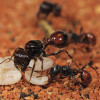Lobsters With The Lurgy
Interview with
Chris - If you're a Caribbean Spiny Lobster and you're ill, don't expect any sympathy. But, don't worry, it's all for the greater good of the population. A team working in the Florida Keys has been looking at a particular virus that infects the Spiny Lobster and has found that fellow lobsters, or conspecifics, that are not infected, try to avoid those that are. Here's Donald Behringer from Old Dominion University in Norfolk, Virginia.
Donald - In the first study we discovered a virus that infects lobsters, specifically Spiny Lobsters down in the Florida Keys, and it turns out to be the first virus discovered to infect any lobster in the world. And what we discovered beyond that is that it has some really interesting impacts in that the healthy lobsters are actually able to detect and avoid infected conspecifics before those infected conspecifics actually become infectious to other lobsters.
Chris - Do you know what the giveaway signs are of an infected lobster then?
Donald - It's not a rapidly progressing virus. In the beginning they really show no outward signs. It takes them anywhere between about 30 to 80 days to show outward signs and that's largely dependent on their size. It progresses much more rapidly in the smaller individuals. But once they do begin to show signs, the signs are that their blood turns a milky white colour; normally it's clear with a grey or an amber tint. And then, along with that, they start to become lethargic; they cease grooming, their movement rates slow down and eventually they don't move at all and then they pass away.
Chris - So it turns into a scruffy lobster, first of all, but what is it that their conspecifics are able to spot about them that you think gives away the fact that they've got something wrong with them?
Donald - Lobsters are very chemically sensitive so we theorise that it's some type of a chemical clue that they're either receiving or not receiving from the infected individuals. But it might be a culmination of visual and chemical clues and that's one of the things that we hope to investigate here in the next year or so.
Chris - So do you know roughly how many lobsters, if you just randomly sample the population, are actually carrying the agent?
Donald - From our field sampling - and we do this yearly. There is a certain suite of sites that we establish as permanent sites that we go back to, to get an idea on whether it's changing in these areas. We also do a larger sampling throughout the Florida Keys each year and the prevalence seems to stay in the range of about 5% to 8%. But those results are from actually looking at them visually and looking for the latter stages of infections. And then, when we actually have gone out and sub-sampled populations in various areas and analysed them using microscopic techniques, histology, it's slightly above that. But we were surprised. We thought when we did the histology that we'd find it much harder than that. But the histology might not be sensitive enough to pick up those really early stage infections.
Chris - Is it a threat to these lobsters or is it not actually making a major dent in the population?
Donald - That's troubling too. We often get the question of is this going to be the death knell for the lobster population. But one of the things we're not clear on is how long it's been in the population. What we do know is that the time that we've been aware of it conclusively and actually had an idea that it was a virus, the prevalence again hasn't changed dramatically. So that's one of the things we want to try and figure out. Hopefully if we can figure out regarding whether it's a chemical detection and if that chemical detection is something very specific to the virus, that might give us an indication of knowing whether these two things actually evolved together or not, the behaviour and this virus.










Comments
Add a comment